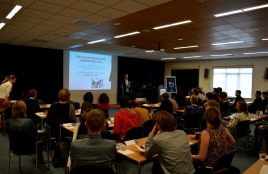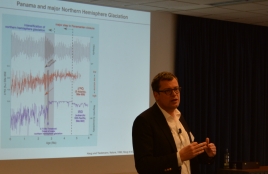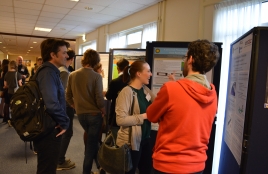NESSC day 2016 was a great success
 A day full of presentations, lectures, posters, food, beers and gezelligheid: the first annual NESSC day was a huge success. More than 65 scientists came together at the Koningshof conference center on April 6th to share their latest insights and explore more ways to collaborate. ‘This is a great way to learn about all the other research that’s going on at my own institute’, said Anne van der Meer, who is a NESSC PhD student at Utrecht University.
A day full of presentations, lectures, posters, food, beers and gezelligheid: the first annual NESSC day was a huge success. More than 65 scientists came together at the Koningshof conference center on April 6th to share their latest insights and explore more ways to collaborate. ‘This is a great way to learn about all the other research that’s going on at my own institute’, said Anne van der Meer, who is a NESSC PhD student at Utrecht University.
The two days after the NESSC day, the joy of meeting peers continues: the NAC (Netherlands Aardwetenschappelijk Congres) hosts more than 200 earth scientists, among whom a lot of NESSC people.
Actual results
 This NESSC day, which was embellished with keynotes by prof. Gerald Haug (Max Planck Institute in Mainz) and prof. Peter Cox (Univ. of Exeter) of the international advisory board of NESSC, was the first official NESSC gathering since the start of the project. The timing of the meeting was therefore really convenient, since a lot of the PhD students and Post Docs had actual results to present. We heard about the salinity proxy Esmee Geerken (NIOZ) is working on, the tipping point models of Sebastian Bathiany (WUR) and the methane oxidizing anaerobic microbes in the gulf of Bothnia of Olivia Rasigraf’s project (RU) – among many others.
This NESSC day, which was embellished with keynotes by prof. Gerald Haug (Max Planck Institute in Mainz) and prof. Peter Cox (Univ. of Exeter) of the international advisory board of NESSC, was the first official NESSC gathering since the start of the project. The timing of the meeting was therefore really convenient, since a lot of the PhD students and Post Docs had actual results to present. We heard about the salinity proxy Esmee Geerken (NIOZ) is working on, the tipping point models of Sebastian Bathiany (WUR) and the methane oxidizing anaerobic microbes in the gulf of Bothnia of Olivia Rasigraf’s project (RU) – among many others.
One of the most important sessions on the NESSC day was the meeting of NESSC PhD students and Post Docs with members of the international advisory board. In four groups they discussed their experiences and research within NESSC. Loes van Bree, PhD student at Utrecht University, said: ‘It was nice to be heard by those scientists from outside NESSC. They were genuinely interested in what we were doing and how we were collaborating.’
Working together
Collaboration is a main theme within NESSC.  All research is divided in workpackages, which are currently exploring how to make more connections between different projects – at the NESSC day, there was a session reserved for this as well. There are some promising results concerning collaboration already: the NESSCwork, PhD and Post Doc network of NESSC, celebrated its first year anniversary this week and is organizing lots of workshops en social gatherings. Francien Peterse, who is a co-promoter within NESSC, said: ‘It’s really good to see that all our young researchers are so active want to be involved with each other’s work. That is quite a difference from when I was a PhD student.’
All research is divided in workpackages, which are currently exploring how to make more connections between different projects – at the NESSC day, there was a session reserved for this as well. There are some promising results concerning collaboration already: the NESSCwork, PhD and Post Doc network of NESSC, celebrated its first year anniversary this week and is organizing lots of workshops en social gatherings. Francien Peterse, who is a co-promoter within NESSC, said: ‘It’s really good to see that all our young researchers are so active want to be involved with each other’s work. That is quite a difference from when I was a PhD student.’
On April 7th and 8th, the NAC conference is held in the same conference venue – including two special NESSC sessions, with lectures by 8 NESSC PhD students and Post Docs.
































































